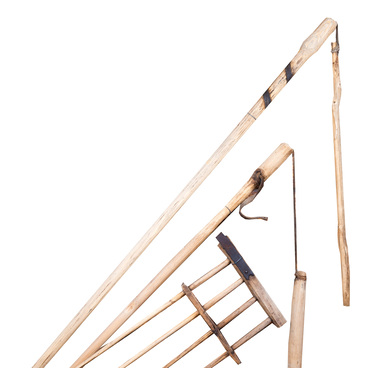A shallow trough is a small tub in the form of an elongated vessel. The museum’s collection has a trough on display made in the XX century. Usually these shallow troughs were made from the part of an aspen or linden tree sawn through the middle: the block was processed and hollowed out from the flat side.
Flour, grains, and cereals were sifted using these troughs, dough products were kneaded, and finished baked goods were cut and folded. The trough could also be used during fairs, when edible goods were put up for sale. When turned upside down, this trough was often used as a large cover. Today, these kinds of vessels no longer enjoy wide popularity, and if they are found in the kitchen it is most likely as a decorative item.
Wood can rightfully be called one of the materials most beloved by Bashkir artisans. Bashkir forests have been, and do remain, an almost inexhaustible source of wood, but just how it is processed has become the key to this material becoming so widespread. Woodworking is considered to be a time-honored occupation for Bashkir artisans. Wooden items were widely used in everyday life. Flour, cereals, grains, lard, and honey were stored in wooden vessels and containers. All kinds of wooden vessels were also used in the kitchen: they kneaded dough in them, churned butter and fermented mare’s milk, and laid out cooked food.
Wooden utensils, depending on the technique used by those making them, could be hollowed out, lathed, or made by a cooper or carpenter. For their part, hollowed out items could be solid or have a detachable bottom. Among the hollowed out wooden products, there were many items that were crucial in a peasant’s everyday household life in the 19th century. They were chiefly made from solid pieces of wood, which were shaped by hewing and shaving off the outside and then hollowing out the wood inside. The process of hollowing an item out began from the center, and went outward towards the edges of the item. Curing the materials for hollowed out vessels made from one piece of wood was done in the springtime. One important social advantage of wooden utensils was that they were available to everyone, regardless of any social or landowner status.
Flour, grains, and cereals were sifted using these troughs, dough products were kneaded, and finished baked goods were cut and folded. The trough could also be used during fairs, when edible goods were put up for sale. When turned upside down, this trough was often used as a large cover. Today, these kinds of vessels no longer enjoy wide popularity, and if they are found in the kitchen it is most likely as a decorative item.
Wood can rightfully be called one of the materials most beloved by Bashkir artisans. Bashkir forests have been, and do remain, an almost inexhaustible source of wood, but just how it is processed has become the key to this material becoming so widespread. Woodworking is considered to be a time-honored occupation for Bashkir artisans. Wooden items were widely used in everyday life. Flour, cereals, grains, lard, and honey were stored in wooden vessels and containers. All kinds of wooden vessels were also used in the kitchen: they kneaded dough in them, churned butter and fermented mare’s milk, and laid out cooked food.
Wooden utensils, depending on the technique used by those making them, could be hollowed out, lathed, or made by a cooper or carpenter. For their part, hollowed out items could be solid or have a detachable bottom. Among the hollowed out wooden products, there were many items that were crucial in a peasant’s everyday household life in the 19th century. They were chiefly made from solid pieces of wood, which were shaped by hewing and shaving off the outside and then hollowing out the wood inside. The process of hollowing an item out began from the center, and went outward towards the edges of the item. Curing the materials for hollowed out vessels made from one piece of wood was done in the springtime. One important social advantage of wooden utensils was that they were available to everyone, regardless of any social or landowner status.



